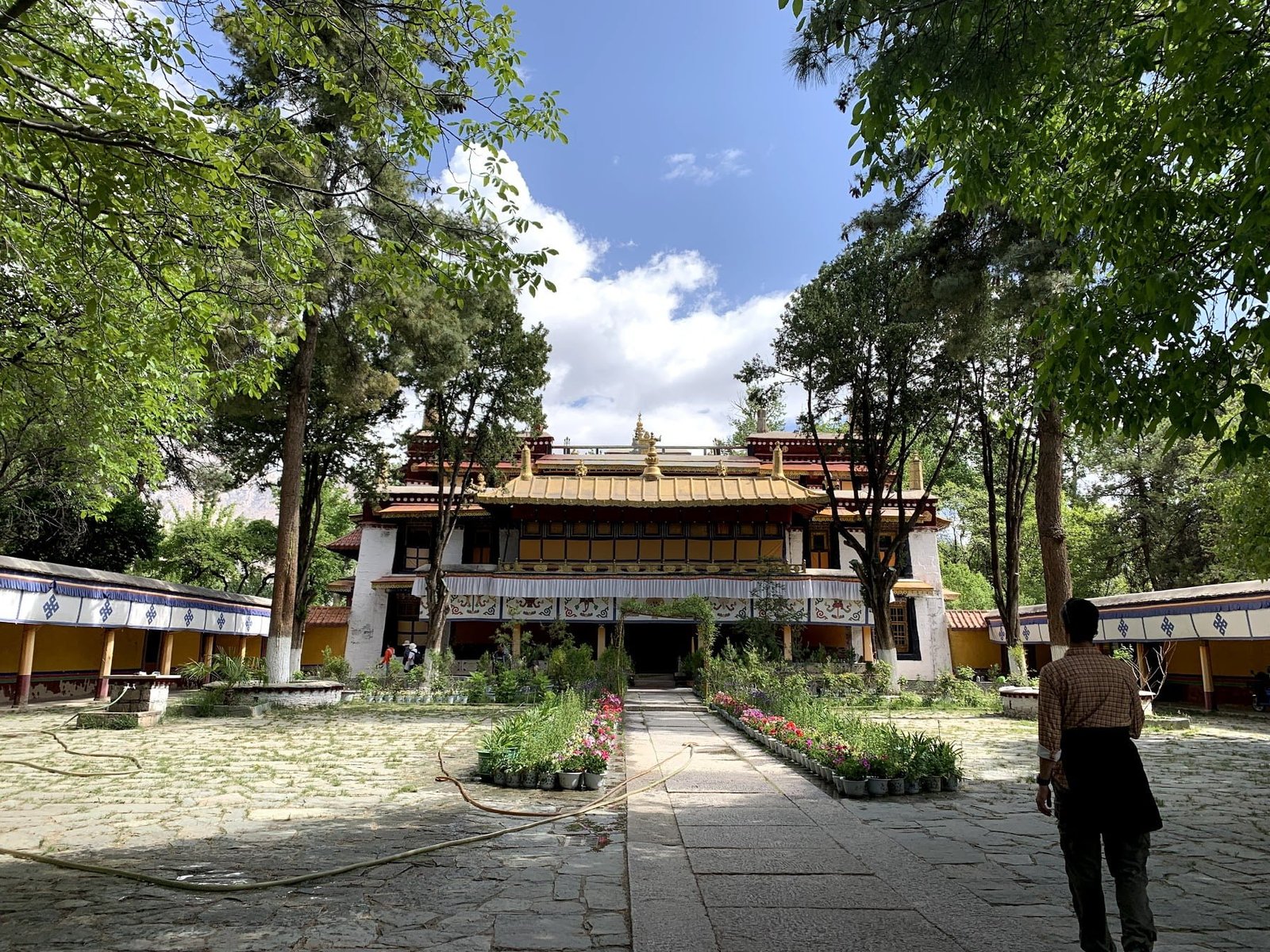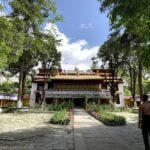The sixth Dalai Lama, Tsangyang Gyatso, born in 1683 AD in the southern region of Tibet, led an extraordinary life that combined athleticism, artistry, and a tragic love story. This article delves into the captivating story of Tsangyang Gyatso, who, despite his rural roots, emerged as a gifted poet and athlete, known for his passionate love poems.
A Remarkable Figure from Humble Beginnings
Tsangyang Gyatso was born to village parents from Menyul, a modest background that didn’t hinder his rise to prominence. From a young age, he displayed remarkable intelligence, and his physical appearance was equally striking. Standing tall and elegant with a rosy complexion and delicate eyebrows, he exuded a majestic presence. His charming demeanour captivated many, especially the young girls of Tibet.
A Master of Athleticism
Not only was Tsangyang Gyatso a charismatic figure, but he also excelled in various physical pursuits. He displayed proficiency in riding, shooting, swordsmanship, and hunting. His athletic prowess earned him the admiration and respect of his peers and subjects.
The Poet of Love
Beyond his athletic accomplishments, Tsangyang Gyatso was a literary folk poet. He is most renowned for his collection of love poems titled “Love Songs,” which is celebrated for its beautiful and expressive language. These poems resonated widely among the people, and they continue to captivate readers to this day.
“Seeing and Not Seeing”
A poignant example of his work is the poem titled “Seeing and Not Seeing,” which reflects the complex emotions of love. In this poem, Tsangyang Gyatso beautifully expresses the enigmatic nature of love and longing.
You either see me or you don’t; I am right there. Neither sad nor happy. You either miss me or you don’t; love exists, neither arriving nor departing. You either love me or you don’t; love remains constant, without growth or decline. Whether you follow me or not, my hand is in yours. Don’t give up. Come into my arms or let me reside in your heart. Love silently, find joy in silence.
This poem was composed by Tsangyang Gyatso for his beloved, Magyami. In a bold and tragic move, he relinquished his position as Dalai Lama for her. Sadly, their love story had a tragic ending, as Magyami was eventually executed by him.
Widespread Influence
The life story of Tsangyang Gyatso adds a layer of romance and mystery to his love poems. His collection, the Lhasa Tibetan woodcut version of “Love Poems of Tsangyang Gyatso,” brings together over sixty passionate verses. Translated into more than 20 languages, it has reached people worldwide, and new translations continue to emerge. Among Tsangyang Gyatso’s extensive body of work, there are more than 200 love poems cherished by Tibetans.
Even today, many songs adapted from his poetry continue to resonate:
That moment, I raise the wind horse, Not for seeking favors, Just awaiting the day of your arrival. I construct a pile of mani stones, Not to accumulate virtue, But to cast them into the lake of my heart. That month, I turned all the prayer wheels, Not to seek transcendence, Just to feel the touch of your fingertips. In this lifetime of wandering, Not for the cycle of reincarnation, But simply to cross paths with you. In that life, I journeyed through mountains, rivers, and pagodas, Not to secure a better afterlife, But to reunite with you on the way…
Unveiling the Enigmatic Life of the Sixth Dalai Lama, Tsangyang Gyatso
In 1683, in the heart of southern Tibet, a member of the Monba ethnic group, Tsangyang Gyatso, took his first breath as a member of a humble peasant family. Raised in a region deeply rooted in the Nyingma religion, known as the Tibetan Red Sect, Tsangyang Gyatso’s life would be marked by his unique background and the religious differences that would shape his destiny.
The Red and Yellow Sects: A Profound Religious Divide
The Tibetan spiritual landscape is a tapestry of diverse beliefs, with the Nyingma and Gelug sects, often referred to as the Red and Yellow Sects, standing at opposing ends of the religious spectrum. One key difference that set them apart was their approach to monastic celibacy. The Red Sect permitted monks to marry and have children, embracing a more relaxed lifestyle, while the Yellow Sect adhered to rigorous rules of celibacy.
This disparity in religious practices would play a significant role in Tsangyang Gyatso’s life and the decisions he would make.
An Uncommon Lineage: Tsangyang Gyatso’s Ethnic Background
What makes Tsangyang Gyatso truly unique among the Dalai Lamas is his ethnic heritage. Unlike his predecessors who belonged to either the Tibetan or Mongolian ethnicity, Tsangyang Gyatso came from the Monba group, setting him apart from the conventional Dalai Lama lineage.
The Hidden Passing of the Fifth Dalai Lama
At the tender age of three, Tsangyang Gyatso’s fate took an unexpected turn. A year prior to his birth, the fifth Dalai Lama had passed away, leaving a void in the spiritual leadership of Tibet. Instead of publicly acknowledging the death, his close disciple, Sangye Gyatso, declared that the Dalai Lama had entered an indefinite state of meditation, effectively concealing the truth.
Sangye Gyatso, often referred to as the “King of Tibet,” wielded immense power during the fifteen-year interregnum between the fifth and sixth Dalai Lamas. However, he was acutely aware of the risks associated with his actions, as the revelation of the fifth Dalai Lama’s passing could have dire consequences. To safeguard his position and provide a contingency plan, Sangye Gyatso initiated a search for the reincarnation of the fifth Dalai Lama, with a unique condition – whoever touched the Dalai Lama’s relics would be deemed the reincarnation.
Tsangyang Gyatso’s Unexpected Ascent to the Dalai Lama
Tsangyang Gyatso’s hometown was selected for this secretive search due to its remote location, simple customs, and limited information flow, making it an ideal choice to maintain confidentiality. Even if the reincarnation was discovered, Sangye Gyatso had no intentions of revealing the truth, as he continued to assert that the fifth Dalai Lama was alive.
The predominance of the Red Sect in this region further supported the decision. The emergence of a Yellow Sect leader here would help facilitate the expansion of the Yellow Sect, a move advantageous for Sangye Gyatso’s agenda.
At the age of three, Tsangyang Gyatso unknowingly became the sixth Dalai Lama when he came into contact with the relics of his predecessor. Once the confirmation was made, Sangye Gyatso breathed a sigh of relief, but he withheld this information from Tsangyang Gyatso’s parents. Little did they know that Tsangyang Gyatso had unwittingly stepped onto a path fraught with challenges and intrigues.
A Different Upbringing for a Dalai Lama
Traditionally, reincarnated soul boys receive rigorous teachings from an early age, with the aim of detaching them from worldly affairs as they mature. However, Tsangyang Gyatso’s upbringing deviated from this norm. He grew up freely, unaware of his destined role as a Dalai Lama. Tsangyang Gyatso had a childhood sweetheart, Rigzin Wangmo, and their love story began at a tender age, with plans to marry when they reached adulthood.
The Unraveling of Secrecy
As history unfolded, the Chinese Emperor Kangxi conquered Junggar and learned of Galdan’s connections with Tibet’s Dibasangye Gyatso. This revelation also exposed the truth that the fifth Dalai Lama had long since passed away. Kangxi, enraged by this revelation, demanded answers from Sangye Gyatso. It was at this critical juncture that Sangye Gyatso’s elaborate exit strategy was set into motion.
He apologized to Kangxi and promptly arranged for Tsangyang Gyatso’s ordination, culminating in a grand enthronement ceremony at the Potala Palace. At the age of 14, Tsangyang Gyatso became the sixth Dalai Lama.
The Struggles of Tsangyang Gyatso
As the new Dalai Lama, Tsangyang Gyatso was thrust into the world of the Yellow Sect, with its strict rules and regulations. Despite his restlessness, he dared not defy Sangye Gyatso’s authority. The longing for his childhood love, Rigzin Wangmo, continued to haunt him, even after Sangye Gyatso falsely claimed that she had already been married.
A Tale of Forbidden Love and Rebellion
When two hearts meet, they etch a bond that cannot be easily broken. Tsangyang Gyatso and Rigzin Wangmo’s love defied the restrictions imposed upon him. Under Sangye Gyatso’s oppressive measures, Tsangyang Gyatso began to rebel, using his actions as a form of self-catharsis. He refused ordination, preached reluctantly, and composed numerous love poems. He would even venture out into the streets of Lhasa under the guise of Dasang Wangbo, where he fell in love with another girl named Dolma.
The Unraveling of a Dalai Lama
Tsangyang Gyatso’s distinct behaviour, marked by long hair, revelry, and romantic entanglements, did not escape the watchful eyes of those opposing the Yellow Sect’s influence. Rumours began to circulate, and accusations against the sixth Dalai Lama grew louder, making him a target for those determined to undermine the Yellow Sect.
Inevitably, Sangye Gyatso imprisoned Tsangyang Gyatso and executed Dolma, tearing apart the young lovers. A power struggle erupted between Sangye Gyatso and Lhazang Khan, ultimately leading to Sangye Gyatso’s death. Lhazang Khan seized the opportunity to inform Emperor Kangxi about Sangye Gyatso’s intentions and Tsangyang Gyatso’s indulgence in worldly pleasures. Enraged, Kangxi ordered Tsangyang Gyatso to be escorted to Beijing.
A Tragic End
In the confines of a prison carriage, Tsangyang Gyatso cast his eyes back upon the landscape he was leaving behind. He contemplated his years of freedom, his love affairs, and his imprisonment. He requested to sit by Qinghai Lake, and once seated, he never rose again.
Tsangyang Gyatso’s life was a remarkable journey, marked by the complexities of Tibetan politics, spirituality, and personal desires. His unique background, tumultuous love story, and his eventual tragic fate paint a vivid portrait of a Dalai Lama like no other.
Frequently Asked Questions
1. Who was Tsangyang Gyatso, and why is he known as the sixth Dalai Lama?
Tsangyang Gyatso was the sixth Dalai Lama, born into a humble peasant family in southern Tibet. He was unique among the Dalai Lamas due to his Monba ethnicity and his association with the Red Sect of Tibetan Buddhism.
2. What led to Tsangyang Gyatso’s unusual ascent to the position of Dalai Lama?
The unexpected death of the fifth Dalai Lama and the subsequent cover-up by his disciple, Sangye Gyatso, paved the way for Tsangyang Gyatso to become the sixth Dalai Lama.
3. What were the challenges Tsangyang Gyatso faced as the Dalai Lama?
As a Dalai Lama from the Red Sect, Tsangyang Gyatso faced the challenge of adapting to the strict rules and regulations of the Yellow Sect, along with the complexities of Tibetan politics and a forbidden love affair.
4. What led to the downfall of Tsangyang Gyatso?
Accusations, rumours, and a power struggle between Sangye Gyatso and Lhazang Khan ultimately led to Tsangyang Gyatso’s imprisonment and tragic fate.
5. Why is Tsangyang Gyatso’s life considered unique and enigmatic?
Tsangyang Gyatso’s life is remarkable due to his unconventional background, his struggles with love and rebellion, and the intricate web of Tibetan politics that surrounded him.
Tsangyang Gyatso, the sixth Dalai Lama, was a multifaceted figure whose life and poetry continue to captivate people around the world. His unique blend of athleticism and poetic artistry, coupled with the tragic love story, makes him a timeless and intriguing character in Tibetan history.
Unique FAQs
- What was Tsangyang Gyatso’s most famous collection of poems?
- Tsangyang Gyatso’s most famous collection of poems is “Love Songs,” celebrated for its beautiful and expressive language.
- Why did Tsangyang Gyatso relinquish his position as Dalai Lama?
- Tsangyang Gyatso gave up his role as Dalai Lama for his beloved, Magyami, which ultimately led to a tragic ending.
- How many love poems did Tsangyang Gyatso compose?
- Tsangyang Gyatso composed more than 200 love poems, which are cherished by Tibetans.
- In how many languages have Tsangyang Gyatso’s love poems been translated?
- Tsangyang Gyatso’s love poems have been translated into more than 20 languages and continue to find new audiences.
- What is the lasting impact of Tsangyang Gyatso’s poetry?
- Tsangyang Gyatso’s poetry continues to inspire and captivate readers around the world, with his work adapted into songs that resonate even today.

















